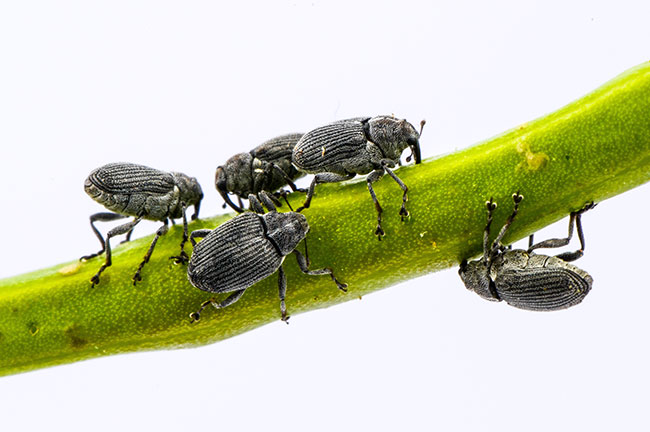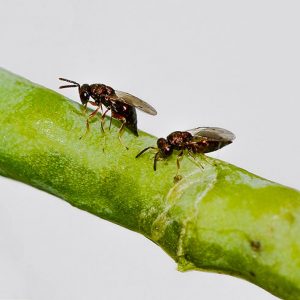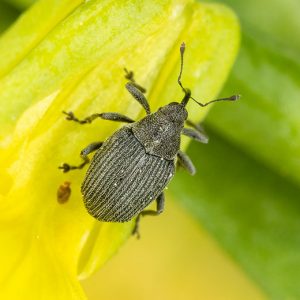
Features
Insect Pests
Wasp versus weevil
Could a tiny wasp have what it takes to control the cabbage seedpod weevil on the Prairies?
November 24, 2020 By Carolyn King
 A national project is investigating the pros and cons of introducing a parasitoid wasp as a biocontrol agent for the cabbage seedpod weevil on the Prairies. PhotoS COURTESY OF Tim Haye, CABI.
A national project is investigating the pros and cons of introducing a parasitoid wasp as a biocontrol agent for the cabbage seedpod weevil on the Prairies. PhotoS COURTESY OF Tim Haye, CABI. The cabbage seedpod weevil, an invasive canola pest, is spreading across the southern Prairies. However, a tiny parasitoid wasp has been keeping this weevil at bay in parts of Quebec – eliminating the need for spraying to control the weevil. Could this wasp be a sustainable, effective tool for managing the weevil’s populations in the west? A national project is underway to answer that question.
An invading menace
The cabbage seedpod weevil (CSW, Ceutorhynchus obstrictus) is not native to North America. Its first detection in Canada was in 1931, when it was found in British Columbia. “On the Prairies, the weevil was first detected in southern Alberta almost 25 years ago. From there, it spread mainly eastward and became established in the Swift Current-Maple Creek area. Since then it has crossed Saskatchewan and has recently been reported in Manitoba,” says Héctor Cárcamo, a research scientist with Agriculture and Agri-Food Canada (AAFC) in Lethbridge, Alta.
“Manitoba is not yet seeing large numbers of the weevil; usually it takes a few years for the insect’s population to develop. However, its presence in Manitoba is a concern because Manitoba provides good habitat for the weevil, given the many acres of canola and the good moisture conditions, both of which seem to favour the pest.”
Interestingly, CSW has had very little northward spread on the Prairies. He says, “Although the weevil has been detected in central Alberta, we have not yet seen damaging populations there. I suspect that the winters are too long and the growing season is too short there for the weevil.”
In Eastern Canada, CSW was first found in Quebec in 2000 and Ontario in 2001. It has become a problem in canola fields in both provinces. “The eastern weevils seem to be from a different source than the ones we have in the west,” Cárcamo notes. “A University of Alberta student looked at the molecular biology and genetics of the two populations and found that they differed considerably from each other.”
In southern Alberta, CSW is a chronic insect pest of canola, especially in fields that are planted early.
“The adult weevils arrive in large numbers at the flowering stage of the canola crop and feed on the pollen. The female usually lays one egg per canola pod when the pods are about an inch long. The larva develops inside the pod, eating the seeds. At the end of the larval period, it chews a hole in the pod and falls to the ground. It pupates in the soil. About two weeks later, the adult emerges and feeds on whatever immature pods of canola or other cruciferous plants are still available in the area,” Cárcamo explains.
“Then the adults migrate to overwintering sites like treed areas or field margins, wherever there is a lot of residue cover so they can hide. Usually in those habitats the temperature doesn’t go below -5 C. The weevils can supercool up to around -7 C, so they can survive the winter easily. As the weather warms in the spring, they emerge and feed on the buds and flowers of early-flowering cruciferous weeds. They move into canola fields as the canola plants begin budding and flowering.”
Improving management strategies
Cárcamo’s CSW research is aimed at developing more sustainable, effective ways to control this pest. At present, insecticides are the main strategy for managing CSW. His research group recently updated the economic threshold for spraying, which is now set at 25 to 40 weevils in 10 sweeps.
His group has also developed a cultural control method that uses a trap crop. “You can either plant two different cultivars at the same time – an early flowering cultivar along the field’s border and a late-flowering one in the rest of the field – or you can plant the border first and then the rest of the field later and harvest at two different times. The weevils concentrate in the early-flowering border, and you spray them with insecticides before they move into the rest of the field,” he explains. “However, we haven’t seen much adoption of that trap crop strategy, I think because growers find it a bit inconvenient. That is why we have turned our attention to biological control of the weevil using a parasitoid wasp called Trichomalus perfectus.
“In Europe, Trichomalus perfectus is one of the most important natural enemies of the cabbage seedpod weevil,” Cárcamo says. This wasp lays an egg into a weevil larva. The egg hatches and the little wasp larva feeds on the weevil larva, gradually killing the weevil larva.
A few years ago, Cárcamo saw an article in Top Crop Manager about research by entomologist Geneviéve Labrie, who had found Trichomalus perfectus in Quebec in 2009 when she was starting her CSW research in that province. Peter Mason, an AAFC-Ottawa entomologist, found the wasp in Ontario in the same year. This non-native parasitoid had not been intentionally introduced in Canada.
Over the next few years, Labrie observed that Trichomalus perfectus was extending its range. By 2015, the wasp was present at almost 70 per cent of her study sites all around Quebec’s canola-growing areas. In fields with the parasitoid, it was providing such effective CSW control that growers no longer needed to spray for the pest.
These exciting findings made Cárcamo wonder whether the wasp could help control CSW in Western Canada. Since the wasp would likely take a very long time to spread naturally from Ontario’s canola fields to the Prairies, he initiated a five-year project to answer key questions around the pros and cons of deliberately introducing Trichomalus perfectus on the Prairies. “You need to get detailed data to assess the potential risks and benefits of introducing a species because, once you introduce it and if it becomes established, there is no way to recall it.”
For this project, which started in 2018, Cárcamo is leading a team of researchers from various agencies who are conducing field surveys, ecological studies and other analyses in Eastern and Western Canada. One possible concern about introducing the wasp had already been investigated before Cárcamo proposed his project. In the past, scientists had wondered whether the wasp, if introduced here, might also attack certain weevil species that have been introduced into Canada for controlling weeds like Canada thistle and scentless chamomile.
“But a few years ago, a European researcher named Tim Haye did a very extensive study on the host range of Trichomalus perfectus. He demonstrated that, although the parasitoid can attack several kinds of weevils, it will actually only go after weevils on the pods and seeds of plants in the Brassicaceae family, like canola and other crucifers,” Cárcamo says. So weevils that feed on non-Brassica plants like Canada thistle and scentless chamomile should be safe from the wasp.
One of the studies in Cárcamo’s project is a collaborative effort led by Cárcamo and Dan Johnson at the University of Lethbridge (U of L). A U of L graduate student is working on the project, and entomologists in Alberta and Saskatchewan are helping with sample collection.
This study consists of a survey of the different weevil species in Prairie canola crops and the natural enemies of these weevils; and an examination of the ecology of CSW and its parasitoids on the Prairies.
From 2001 to 2006, entomologist Lloyd Dosdall led surveys of the native parasitoids of CSW in southern Alberta and Saskatchewan. Those surveys found a total of 15 parasitoid species attacking the weevil, including 14 species that parasitized the weevil’s larvae. At that time, only five per cent or less of CSW larvae were parasitized, and total parasitism of CSW was generally less than 15 per cent.
“So far, our student is finding similar results; the level of parasitism by native wasps has not increased very much,” Cárcamo says. “So there is still room to introduce another parasitoid that could perhaps help bring the cabbage seedpod weevil under control.”
Because Trichomalus perfectus is already present in Ontario and Quebec, the collaborating researchers in those provinces are able to investigate the wasp’s actual behaviour in the field. In both provinces, they are collecting the larvae of the different weevil species found in canola and other Brassica plants, and determining which weevil species are being attacked by the wasp. In Quebec, the researchers are also evaluating how effective this parasitoid is in controlling CSW, and they plan to analyze the parasitoid’s economic impact on Quebec canola production. The Quebec researchers are also studying the overwintering biology of CSW and Trichomalus perfectus, which will increase understanding of the two insects and their potential spread in Canada.
According to Cárcamo, one of the challenges so far is that the canola acres in these two provinces have dropped in the last couple of years. As a result, the researchers are finding that the populations of both the weevil and the parasitoid have declined.
Another component of the project involves modelling to predict where the parasitoid wasp might become successfully established.
A few years ago, Tim Haye and several AAFC researchers, including Owen Olfert, Peter Mason and others, used advanced bio-climatic modelling to predict the potential distribution of Trichomalus perfectus if it were introduced in Canada. According to that analysis, some of Canada’s canola-growing regions are potentially suitable for this parasitoid to become established. However, Canadian conditions would not be as good as for the wasp as the conditions in parts of Europe, and the southern Prairies would be less suitable than Eastern Canada.
“Now that we have the parasitoid in more areas in Quebec and Ontario, we can refine and validate that model using the current distribution of the parasitoid in Eastern Canada,” Cárcamo explains.
“That might allow us to see if there are some specific habitats [in the southern Prairies] where the wasp could become established. [For example, perhaps irrigated fields might provide better conditions than the hotter, drier surrounding lands.] And those would be the areas where we would release the parasitoid.”
The project also includes studies in Alberta and Quebec to understand how different landscapes affect CSW, lygus bugs and their natural enemies. The field sampling for these studies involves taking a number of sweeps at a given point in a canola field to determine the insect community at that location, and then collecting habitat data within a two-kilometre radius of the sampling point.
The researchers will analyze the collected information to see how factors like crop rotations and plant species in natural areas relate to the abundance of the pest, the amount of crop damage by the pest, and the abundance and effectiveness of the pest’s natural enemies. “For instance, if a natural area near a crop field has wild flowers where parasitoid wasps can feed on nectar, then these wasps might have more energy to fly and attack the pest in the crop. Or an uncultivated area that is not sprayed with an insecticide might have increasing populations of beneficial predator insects that could move into the crop.”
Weevil control without insecticides
“In any integrated pest management program, we don’t want to eradicate the pest – even if we wanted to do that, it is impossible. The goal is to prevent the pest’s population from reaching the economic threshold for spraying,” Cárcamo explains.
“If Trichomalus perfectus took even as little as 20 or 30 per cent of the cabbage seedpod weevils, that might be enough to prevent most canola fields from needing an insecticide application to control this weevil.
“That would obviously be quite beneficial in terms of saving money for growers. It would also be highly beneficial in terms of protecting honey bees, bumblebees and other pollinators that are part of the native biodiversity.
“Also, by not spraying insecticides, you could enhance populations of the weevil’s other natural enemies. For example, we think ground beetles, spiders and/or other predators are likely eating the cabbage seedpod weevil – we have a student doing a study on that right now. So adding Trichomalus perfectus could result in a stronger community of natural enemies and an even greater impact on the weevil’s population.”
This project is funded under the Canola Science Cluster, with AAFC and the Canola Council of Canada as the main funders.

